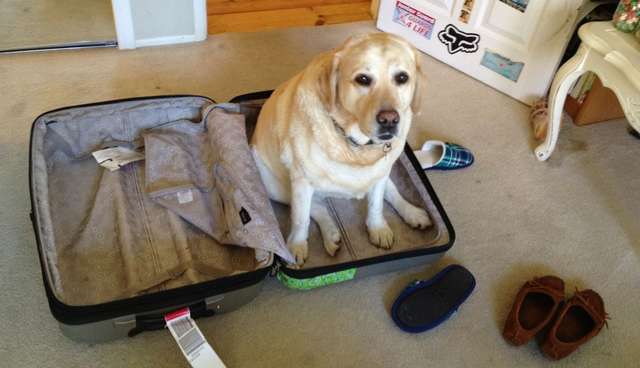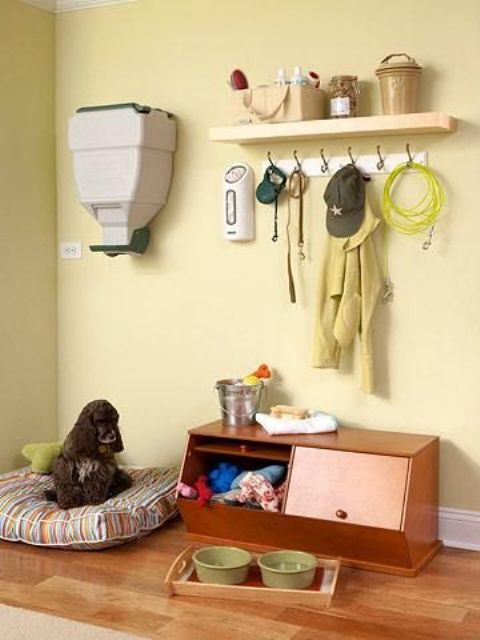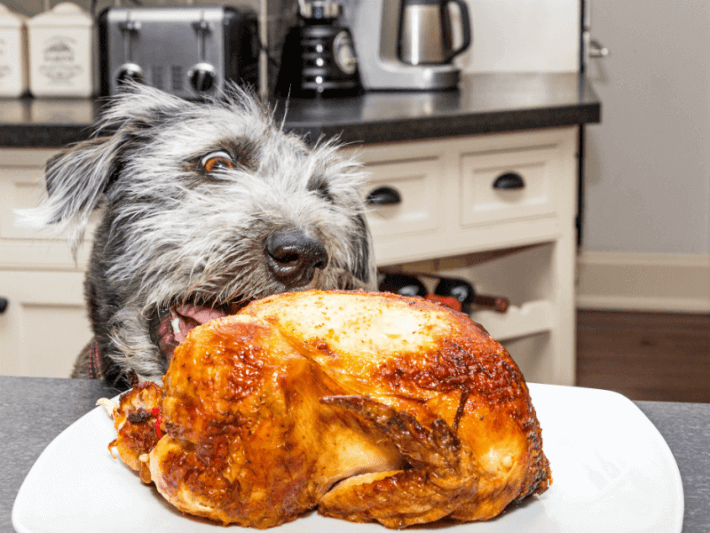From Art S. My dog hasn’t moved much in the last 20 years. How do I get life into her?
Art, I believe you need to take a careful look at your dog. Start with the eyes: are they fixed and glassy? Perhaps even actual glass? If the tongue is protruding, is it dry and clothlike? Finally, look at the belly and hind legs: do you notice a tag or label of any sort sticking out? If so, your dog is a stuffed toy. Congratulations on your low-maintenance pet!

From Paige L. Do you find that the owners have more anxiety about the pets than the pets do?
Yes, I'd say the owners are more anxious. But that's because they have a bigger brain and understand what's going on. ("We're leaving and won't be home for two weeks!") There's always a little apprehension when leaving your pet in someone else's care. It's understandable to wonder if a change in routine will be upsetting to the pet, or if they will be lonely/worried/bored when family members leave. But I find that most dogs and cats take it very much in stride.
Some pet owners leave very detailed instructions for meal preparation and care, and I love that. I always say "the more you tell me, the better I can do my job". I want to provide care that maintains the pet's regular routine as much as possible. Being in their own home, going for walks in their own neighborhood, and eating their accustomed food at the usual time helps them feel like things are okay.
Some pet owners leave very detailed instructions for meal preparation and care, and I love that. I always say "the more you tell me, the better I can do my job". I want to provide care that maintains the pet's regular routine as much as possible. Being in their own home, going for walks in their own neighborhood, and eating their accustomed food at the usual time helps them feel like things are okay.
It's very rewarding to have clients tell me that they are less stressed about going away because they know their pets are happy under my care.

From Paige L. What is the best way to prepare your pets for a pet sitter coming in?
The most important thing is to have your dog well-socialized. A dog that's used to meeting people outside of the family will be more relaxed and welcoming when a petsitter arrives. This isn't something you can do in a few days before you leave for vacation, though. Antisocial cats aren't a problem; a list of their preferred hiding places is appreciated so I can make sure they're around and avoiding me, rather than actually missing.
Try to have things arranged as they usually are. If your pet is used to having the run of the house, don't decide to keep them shut in the garage or a spare room "to make it easier". I've seen dogs dig through drywall when they feel stressed and trapped.
Make sure that there are enough supplies (food, litter, etc) to last until you come back. Have these supplies in a location that makes sense, for example, have extra cat litter near the cat box, not stored on a top shelf in the detached garage. I will go shopping for supplies of your preferred brands if I run out, but there's an additional charge for that because of the inconvenience.
Sometimes I need cleaning supplies to manage messes. A bucket with cleaners and a roll of paper towels or some rags is a super handy thing to leave out for me.
 |
| This is a petsitter's dream! So organized! |
From Karen E. How do I get my dog to stop pulling on the leash when I take her for a walk?
From Lori B. I have a leash puller. Other than that, she's delightful. How do you stop a 60 lb retriever from taking YOU on the walk?
Oh, this is my favorite question! Here's the simple answer: don't let them. For more details, see my blog posts here on the magic and science of dog walking. I wrote a whole series. It takes time and you have to be consistent, especially when you have an adult dog that needs retraining, rather than a puppy, but it's totally doable -- and usually you don't need any special tools, just a regular collar and six-foot leash.
From Elias T. What do you do with a dog who is generally a well behaved dog, but won't stop jumping on people when they come in the house?
You introduce the magic of "sit." Right now, your dog jumps and dances because that's what she's always done and you haven't told her to do anything different.
Keep some small treats by the door. When you come in, ask her to sit and give her a treat when she does. Don't stand there watching her bounce around while you say sit sit sit sit sit Sit Sit Sit SIT SIT SIT DARN YOU THIS ISN'T WORKING SIIIIIIIT. That way she's still getting your attention and you're just saying weird sounds but oh well I guess this is how it goes now. Walk in, say SIT and if she doesn't, turn away. Look at your phone or something. Don't push her away or anything. Just pretend she's not there. She'll jump and bark probably, escalating her behavior because HELLO I AM HERE HELLO PET MEEEEEEE and don't you DARE give in to that. Just wait. Eventually, three hours later, she will stop in confusion (or fatigue) and sit down to think about why you are being so weird. Yes! Sit! you say, and finally give her that treat.
Then go outside again.
Wait, what?
Keep some small treats by the door. When you come in, ask her to sit and give her a treat when she does. Don't stand there watching her bounce around while you say sit sit sit sit sit Sit Sit Sit SIT SIT SIT DARN YOU THIS ISN'T WORKING SIIIIIIIT. That way she's still getting your attention and you're just saying weird sounds but oh well I guess this is how it goes now. Walk in, say SIT and if she doesn't, turn away. Look at your phone or something. Don't push her away or anything. Just pretend she's not there. She'll jump and bark probably, escalating her behavior because HELLO I AM HERE HELLO PET MEEEEEEE and don't you DARE give in to that. Just wait. Eventually, three hours later, she will stop in confusion (or fatigue) and sit down to think about why you are being so weird. Yes! Sit! you say, and finally give her that treat.
Then go outside again.
Wait, what?
Yep. This isn't something that will be fixed in one or two tries. Out you go. Wait a few minutes and then come back in. Say SIT and repeat what you did before, ignoring that bouncing dog and only giving her attention when she sits and is quiet.
But that will take forever!
Yes it will. Or at least it will feel that way. And believe me, it's not fun for her either-- she's going to be confused. It's how you would feel if a friend came to visit and was suddenly speaking a foreign language. Come on, you'd say. Let's speak English like I'm used to! I don't understand what you're saying. So you make it easier by being calm and quiet and saying that one word you know that she knows: "sit".
She's a smart dog. She wants to do the right thing -- you say she's well-behaved. You'll probably notice the little light bulb over her head click on about the fifth time you come through the door. OOOH I get attention when I sit! then she'll stop jumping and start sitting faster and faster.
Again, you'll have to be consistent. And you'll have to tell everyone who comes in to ignore her as well, until she learns.
Alternatively, you could give her a roast chicken every time you come in, and then she'll be so busy eating chicken that she won't have time to jump. But that's gonna be a lot of chicken.
Again, you'll have to be consistent. And you'll have to tell everyone who comes in to ignore her as well, until she learns.
Alternatively, you could give her a roast chicken every time you come in, and then she'll be so busy eating chicken that she won't have time to jump. But that's gonna be a lot of chicken.

From Laura O. Can you teach an old dog new tricks? Or manners?
Absolutely! Any dog can learn new behaviors, although your success will be determined by how consistent you are and how valuable the reward is for the dog.
It's easier to teach a dog something new than it is to get then to un-learn an established behavior. If your dog is used to sleeping on the couch, for example, and then you get a new couch and decide that you'd rather it wasn't covered in pawprints and dog hair so the new rule is "No dogs on the couch", it's going to take some time to break that habit -- especially if there's someone else in the home that says things like "It's just a for a little while," or "But he looks so comfortable!"
Thank you for your questions, everyone! I'm always happy to talk about what I do. Keep sending me more, and I'll answer them in upcoming blog posts.
No comments:
Post a Comment